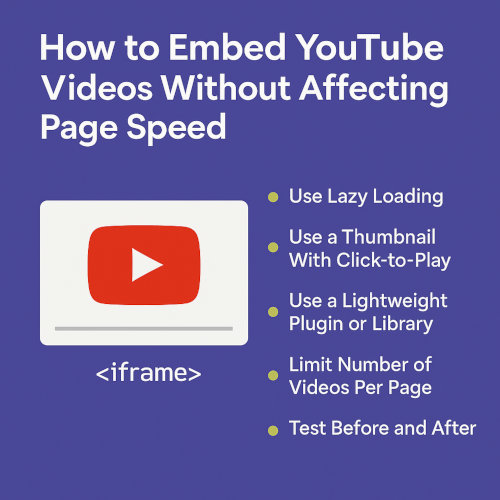How to Embed YouTube Videos Without Affecting Page Speed
Embedding YouTube videos can enrich your content and engage visitors, but it can also slow down your website if not done the right way. For bloggers, content creators and site owners, page speed directly affects user experience and SEO. This guide shows you how to embed YouTube videos the smart way, without compromising site performance.

Why YouTube Embeds Can Hurt Your Website's Page Speed
When you embed a YouTube video using the standard <iframe> method, it loads multiple scripts, styles and external resources behind the scenes. These can add significant weight to your page, slowing down load times especially on mobile phones.
This becomes a problem when you have multiple videos on a page or want to maintain fast load speeds to satisfy both users and search engines like Google PageSpeed Insights.
Impact of Slow Loading Videos
Slow video embeds may lead to a number of unwanted things such as:
- Poor user experience,
- Lower Core Web Vitals scores,
- Reduced engagement or higher bounce rates,
- Worse search rankings due to slow page speed,
Best Practices to Embed YouTube Videos Without Slowing Your Site
1. Use Lazy Loading
Lazy loading defers the loading of the video player until the user scrolls to it. This means the browser doesn't load it until it's needed.
<iframe loading="lazy" width="560" height="315" src="https://www.youtube.com/embed/VIDEO_ID" frameborder="0" allowfullscreen></iframe>
Most modern browsers support the loading="lazy" attribute, and it's the easiest way to improve performance. Here's an example:
2. Use a Thumbnail With a Click-to-Play Function
Instead of loading the full iframe, show a static placeholder image or thumbnail and only load the iframe when the user clicks.
This is typically done with JavaScript. Here's a simple example:
<div class="video-wrapper">
<a href="https://www.youtube.com/watch?v=VIDEO_ID" target="_blank">
<img src="https://img.youtube.com/vi/VIDEO_ID/hqdefault.jpg" alt="Video Thumbnail">
</a>
</div>
You can enhance this by using custom play buttons and overlays.
3. Use a Lightweight YouTube Embed Plugin or Library
If you're using WordPress or building with JavaScript, there are many libraries that help with this. Examples include:
- Lazy Load for Videos WordPress plugin
- Lite YouTube Embed library
These replace the heavy YouTube iframe with a lightweight placeholder and only load the full player on click.
4. Limit the Number of Embedded Videos Per Page
Don't overload a single page with too many videos. Try to embed only one or two important videos and link the rest externally.
This reduces the number of third-party calls and speeds up rendering.
5. Preload or Preconnect to YouTube Domains (Advanced)
Using HTML's <link rel="preconnect"> can reduce time to first byte by initiating early connections to YouTube.
<link rel="preconnect" href="https://www.youtube.com">
<link rel="preconnect" href="https://www.google.com">
<link rel="dns-prefetch" href="https://www.youtube.com">
Use this technique sparingly and only when you're sure users will engage with the video content.
Test Before and After
Once you implement the optimize the embedding method, always test your site with tools like:
Compare the before and after loading time values to ensure you're seeing actual improvements in speed and interactivity.
Embedding YouTube videos without dragging down your website speed is entirely possible. Whether you're using lazy loading, click-to-play thumbnails or plugins, each method can boost your site's performance and SEO. With video content continuing to dominate, using these techniques ensures a fast, user-friendly and media-rich experience for your audience.
